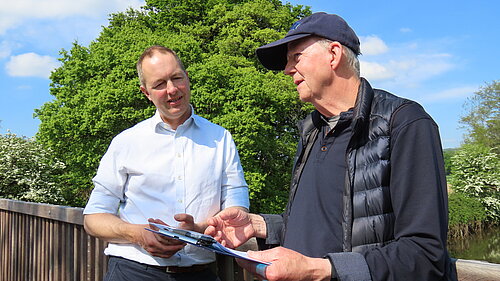#ReviveTheRiverOtter: Local people urged to take action in new campaign to restore “sick” watercourse

A Devon MP has joined forces with a community activist group, in a powerful new campaign to restore the health of an ailing local river, currently rated ‘poor’ by the Environment Agency.
The middle and lower reaches of the River Otter are now so contaminated with **sewage related pollutants, that it is classed in the bottom 20 per cent of rivers in England for water quality.
Figures from local environmental groups suggest that the River Otter has the highest phosphate levels of any major watercourse in Devon and Cornwall.
70 per cent of phosphate levels in the Otter come from the sewage system
The Environment Agency considers that around 70 per cent of phosphate levels in the Otter come from the sewage system.
In 2024, South West Water discharged untreated sewage into the River Otter for over 15,000 hours, and there are high levels of phosphate in the treated discharge, pumped into the river 24 hours a day, every day, from their treatment works.
Local people are being urged to join the campaign
Local people are being urged to join the campaign, which is spearheaded by the Otter Valley Association (OVA), and aims to persuade South West Water to adequately invest in local sewage infrastructure, to allow the river to flourish once again.
The campaign is strongly backed by Richard Foord, MP for Honiton & Sidmouth, who met with OVA representatives in May to observe water quality testing on the river. Mr Foord then called a meeting with South West Water, which took place last month and was attended by the OVA, representatives from the Environment Agency, and the River Otter Fisheries Association, whose members are also concerned about the river’s pollution levels.
South West Water has no plans to invest in local sewage infrastructure to stop the pollution in the river
South West Water representatives stated at the meeting that they have no plans to invest in the sewage infrastructure that discharges into the middle and lower sections of the Otter, for at least the next five years and most likely much longer.
The lifeblood of our landscape
Haylor Lass, Chairman of the Otter Valley Association, said: “This river is the lifeblood of our landscape, and it’s been neglected for far too long. We are standing together—locals, anglers, experts, and nature lovers—to give the Otter back its sparkle.”
Richard Foord, added: “The river Otter should be crystal clear and teeming with fish and invertebrates, but instead, the middle and lower sections are murky, slimy and sick. This is largely due to untreated or inadequately treated sewage being endlessly discharged in the river, by South West Water.
“We felt we had no option to but to launch #ReviveTheRiverOtter to stop SWWs appalling use of the River Otter as a free extension of their sewage infrastructure. This is just the start. We’ll keep going until we succeed in getting the investment the River Otter desperately needs to thrive once again.
“I want to pay tribute to the remarkable work of volunteers at the Otter Valley Association. Their data, expertise, clear objectives and mobilisation of the local community for water quality testing is very impressive. I was taken aback by their efforts when I met them, and I am backing them to the hilt in their endeavours.”
Forty eight volunteers test the Otter’s quality every two weeks
For the last four months, the Otter Valley Association has mobilised forty-eight dedicated volunteers who have been monitoring the river’s health at 12 strategic locations stretching from Honiton to the sea, measuring 10 different indicators of ecological health.
Water quality testing takes place every two weeks, forming one of the most comprehensive citizen science efforts in the region. In the latest round of testing, Phosphate levels were found to be over four times the ecological ‘upper safe limit’, peaking at six times just downstream of the major sewage works.
Peter Williams, OVA lead analyst, summarises the quality issues: “The data shows the Otter has the highest phosphate levels of any major river in Devon and Cornwall, and goes some way to explaining why it’s the only river system in the area classified as ‘poor’ by the Environment Agency. High levels of phosphate cause slimy algal blooms on the riverbed and decreased oxygen levels, leading to severe consequences for plant life, wildlife and fish populations.
“According to the Environment Agency, approximately 70 percent of the phosphate entering the Otter is a result of discharges from South West Water’s sewage infrastructure.”
#RevivetheRiverOtter is urging residents to take photos of the river
The first stage of #ReviveTheRiverOtter campaign asks residents to take photographs of their most and least favourite parts of the Otter over the summer and post them on their social media channels, using the hashtag #ReviveTheRiverOtter.
For impact, local people are asked to also tag Richard Foord on Facebook and Bluesky, the Otter Valley Association on Facebook and South West Water on Instagram, Facebook and X.
Stage two of the campaign will take place in the autumn
The OVA and Richard Foord have plans for stepping up the campaign in the autumn, if they do not see commitments from South West Water to invest in the local sewage treatment works that serves to prevent raw and inadequately treated sewage being discharged into the River Otter.
Sign up for updates on the Otter
Sign up for updates on the campaign to #ReviveTheRiverOtter